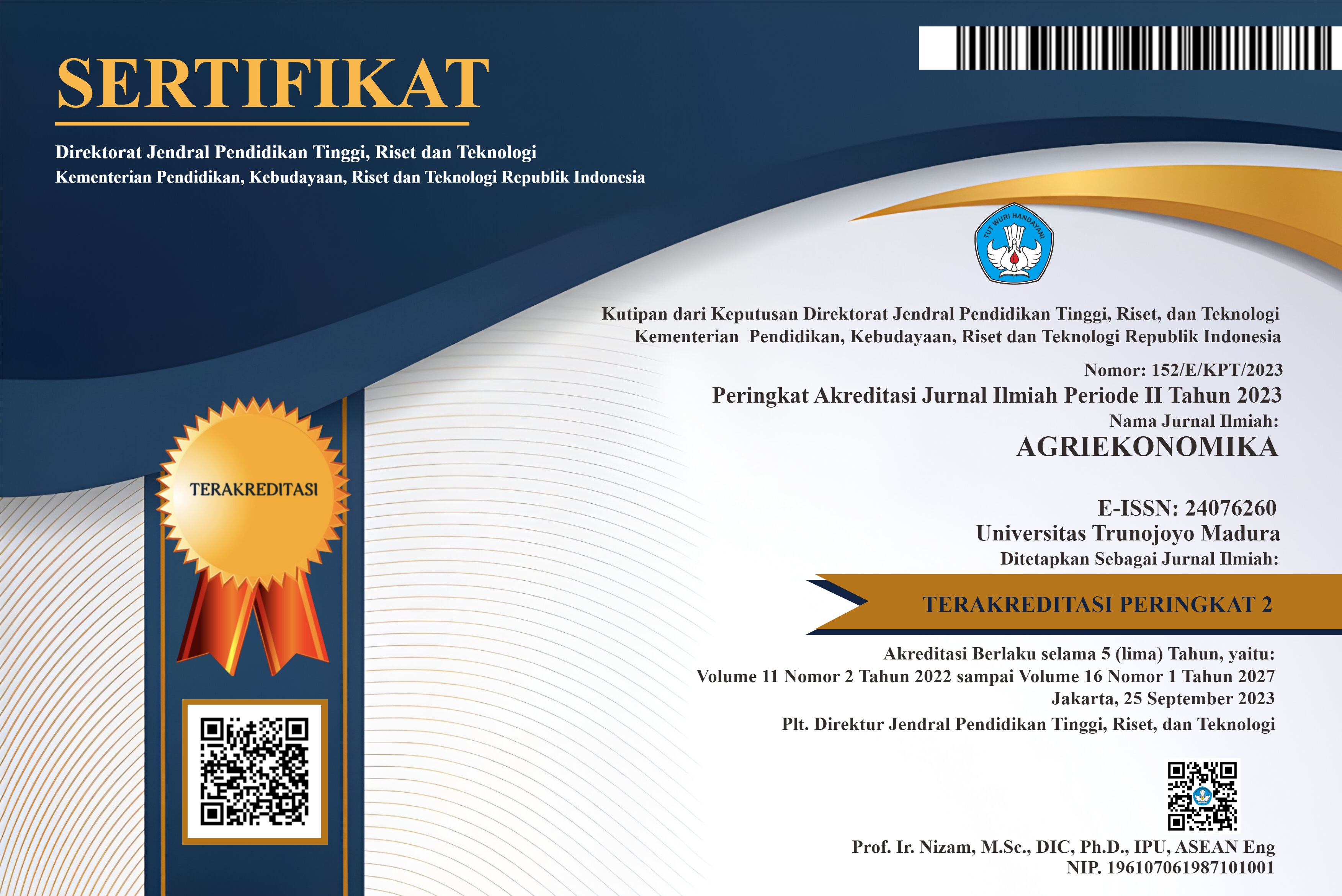Australian Salt Import Policy in Indonesia: An Analysis of Public Policy
Abstract
The purpose of this study is to examine how economic variables such as the Import of Australian Salt, Domestic Salt Consumption, Domestic Salt Production, GDP Industrial Sector consisting of textile, leather, and pharmaceutical Industry, Cost Insurance Freight (CIF), Australian Dollar Exchange Rate, and non-economic variables respond to the enactment of Government Regulation Number 9 of 2018. The method used is the Feasible Generalized Least Square (FGLS) by observing the dynamic relationship between independent and dependent variables in quarterly data from 2010 to 2021. The results show that Australia's salt imports are smaller than before the enactment of PP No. 9 of 2018. Second, public policy choices in international trade politics for the case of salt imports still prioritize economic benefits (economic scale). Third, the test results show that even though the CIF of imported salt increases, it is inelastic to a decrease in demand. Lastly, the study states that if domestic demand for salt increases with the assumption that national salt production increases, Australian salt imports can be reduced. Our short suggestions are first, the government needs to invest in physical and human technology to reform salt production technology.
Keywords
Full Text:
PDFReferences
Alfiani, L. F. (2021). Antinomi Peraturan Perundang-Undangan Mengenai Impor Garam Nasional. Jatiswara, 36(1), 24–37. https://doi.org/10.29303/jatiswara.v36i1.277
Ariefianto, Moch. Doddy. Ekonometrika Esensi dan Aplikasi Dengan Menggunakan Eviews. Jakarta : Penerbit Erlangga
Aris, T., Mamahit, D. A., & Ras, A. R. (2022). Indonesian Salt Import Policy as A Threat and Opportunity in The Concept of Blue Economy in Indonesia. Jurnal Pamator : Jurnal Ilmiah Universitas Trunojoyo, 15(1), 1–13. https://doi.org/10.21107/pamator.v15i1.14239
Boenarco, I. S. (2012). Kebijakan Impor Garam Indonesia (2004-2010): Implikasi Liberalisasi Perdagangan Terhadap Sektor Pergaraman Nasional. In Fakultas Ilmu Sosial Dan Ilmu Politik Program Studi Hubungan Internasional Ui. http://lib.ui.ac.id/file?file=digital/20300588-T30500-Intan Sari Boenarco.pdf.
Badan Pusat Statistik. (2022). Impor Garam Menurut Negara Asal Utama. Diakses tanggal 2 September 2022 dari https://www.bps.go.id/statictable/2019/02/14/2013/impor-garam-menurut-negara-asal-utama-2010-2017.html
Ghodsi, M., Grübler, J., & Stehrer, R. (2016). Import Demand Elasticities Revisited. 132.
Greene, W. H. (2003). ECONOMETRIC ANALYSIS Senior Media Project Manager : Victoria Anderson Production Editor : Michael Reynolds.
Gujarati, D. N. (2003). Basic Econometric (Fourth). McGraw Hill.
Hiau, L. K., Nicita, A., & Olarreaga, M. (2008). Import demand elasticities and trade distortions. Review of Economics and Statistics, 90(4), 666–682. https://doi.org/10.1162/rest.90.4.666
Jamil, A. S., Tinaprilla, N., & Suharno, . (2017). Faktor-Faktor Yang Mempengaruhi Permintaan Dan Efektivitas Kebijakan Impor Garam Indonesia. Buletin Ilmiah Litbang Perdagangan, 11(1), 43–68. https://doi.org/10.30908/bilp.v11i1.73
Kebbi, B. (2017). Ife Social Sciences Review Nigeria s Export Supply versus Brazil’s Import Demand : 25(2), 48–58.
Khairunnisa. (2015). Model Kebijakan Indonesia Terhadap Australia Dalam Melindungi Industri Garam Nasional (2009-2011). Jom Fisip, 2(2). https://medium.com/@arifwicaksanaa/pengertian-use-case-a7e576e1b6bf
Mardoni, Z. (2022). Analysis of Salt Production, Consumption and Import in Indonesia. International Journal of Science and Society, 4(1), 36–49. https://doi.org/10.54783/ijsoc.v4i1.414
N. Gregory Mankiw. (2013). Macroeconomics; Eighth Edition.
Nagaraja. (2015). Economics of salt production in India: an Analysis. Indian Journal of Applied Research, 5(11), 284–288.
Peraturan Menteri Perdagangan. (2019). Nomor 63 Tahun 2019 tentang Ketentuan Impor Garam. Jakarta: Kementerian Hukum dan Hak Asasi Manusia RI. https://jdih.kemendag.go.id/pdf/Regulasi/2019/Permendag%20No.%2063%20Tahun%202019.pdf
Peraturan Pemerintah RI Nomor 9 Tahun 2018 tentang Tata Cara Pengendalian Impor Komoditas Perikanan dan Komoditas Pergaraman. Jakarta: Sekretariat Negara. https://peraturan.bpk.go.id/Home/Details/72811/pp-no-9-tahun-2018
Prasetyo SW, A. (2016). Petani Garam vs Impor Garam Indikasi Besarnya Ketergantungan Belanja Daerah terhadap Dana Perimbangan. Buletin APBN, I(18), 2–4. http://berkas.dpr.go.id/puskajianggaran/buletin-apbn/public-file/buletin-apbn-public-18.pdf
Pusat Riset Kelautan BPSDMKP KKP. (2022). Telaah : Prediksi Produksi Garam Nasional 2022 (Vol. 2022).
Razi, F., Ismayani, I., & Iskandar, E. (2016). Analisis Perkembangan Dan Faktor-Faktor Yang Mempengaruhi Impor Garam Di Provinsi Aceh. Jurnal Ilmiah Mahasiswa Pertanian, 1(1), 346–352. https://doi.org/10.17969/jimfp.v1i1.1331
Salim, Z., & Munadi, E. (2016). Info Komoditi Garam. In Al Mawardi Prima. https://bppp.kemendag.go.id
Sirait, R. A., Paramita, R., Dahiri, Prasetyo, A., Ramiayu, D. D., & Kusumawardhani, R. T. (2021). Mengurangi Ketergantungan Impor Garam. Industri Dan Pembangunan Budget, 1(1), 1–8.
Soesastro, M. H. (2021). The Political Economy of Deregulation in Indonesia. Polit Journal Scientific Journal of Politics, 1(1), 36–46. https://doi.org/10.2307/2644831
Tridge. (2021). Benchmark Report: Salt (Issue January).
USGS. (2021). Mineral Commodity Summaries 2021. U.S., Department of The Interior and Geological Survey.
World Integrated Trade Solution. (2012). Import Trade. Diakses tanggal 3 September 2022 dari http://www.wits.org
Wardianingsih, R., & Paramita, R. (2022). Menilik Sebab Impor Garam. In Buletin APBN: Vol. VII (Issue 2020, pp. 7–10).
DOI: https://doi.org/10.21107/agriekonomika.v12i1.19032
Refbacks
- There are currently no refbacks.







